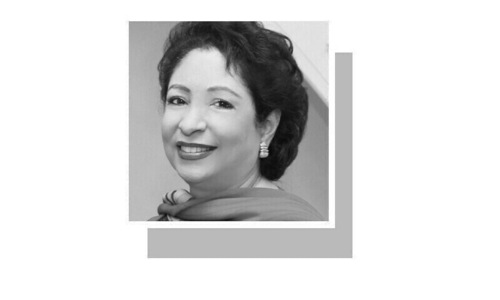
ISLAMABAD: As the number of voters across Pakistan swells to over 128 million per the latest statistics, the electoral gender gap for the first time in a decade has reduced to less than 10 million, with at least 59.32 million women (46.13pc) registered as voters compared to 69.26 million men (53.87pc).
An analysis of the data by Dawn showed that out of the total gender gap of 9.94m, Punjab contributes a difference of over five million, followed by Sindh (2.24m), Khyber Pakhtunkhwa (1.96m), and Balochistan (0.660m). The total number of registered voters in Punjab stands at 73.20m, including 39.12m (53.44pc) male and 34.09m (46.56pc) female voters.
Sindh has 26.99m people enrolled as voters, including 14.61m (54.13pc) male and 12.38m (45.87pc) female voters. Khyber Pakhtunkhwa has a total of 21.83m voters, out of which 11.94m (54.47pc) are men and 9.98m (45.53pc) are women.
The total number of voters in Balochistan is 5.37m — slightly higher than the gender gap among voters in Punjab. This includes a little over three million (56.15pc) male and 2.36m (43.85pc) female. In Islamabad’s over one million voters, the number of male voters is 0.568m (53.48pc), while 0.514m women (47.52pc) are registered on electoral rolls.
Difference between proportion of male, female voters lowest in two Balochistan, six Punjab districts
Gender gap
Just seven districts of Punjab contribute to a gender gap of around two million. These include provincial capital Lahore (0.414m), Faisalabad (0.384m), Gujranwala (0.256m), Rahim Yar Khan (0.254m), Kasur (0.221m), Sheikhupura (0.212m) and Sialkot (0.211m). Sheikhupura is the only district in Punjab to have a proportion of female voters below 45pc. The women in the district constitute 44.96pc of the total voters.
Other districts of the province with huge gaps include Bahawalpur (0.17m), Multan (0.17m), Vehari, Sargodha, Okara and Bahawalnagar (0.16m), Khanewal (0.14m), Sahiwal (0.14m), Dera Ghazi Khan (0.13m), and Muzaffargarh (0.12m).
Punjab, on the other hand, has the distinction of having six out of a total of eight districts across the country with more than 48pc women voters.
The other two districts are from Balochistan, where 20 out of 35 districts have a difference of over 10pc in the numbers of male and female voters.
Chakwal is at the top with the proportion of women voters as high as 49.42pc, followed by 49.02pc in Talagang, which used to be part of Chakwal before it was declared a district last year. Jhelum has 48.53pc female voters followed by Rawalpindi with 48.49pc, Attock with 48.31pc, and Khushab with 48.15pc women voters. Balochistan’s Sohbatpur and Usta Muhammad districts have 48.72pc and 48.07pc women on the electoral rolls.
As many as eight districts of Sindh have a gap of over 100,000 in the number of male and female voters, which includes three districts having less than 45pc women enrolled as voters. In Keamari, the proportion of women among registered voters is as less as 41.87pc, followed by Karachi West (42.30pc) and Malir (43.36pc).
Karachi (Central) had a gap of 0.16m among the male and female voters. The other districts with a gap of over 100,000 include Karachi (East), Karachi (South), Korangi, and Hyderabad.
Khairpur, Matiari, and Umer Kot are the only three out of 30 districts in Sindh to have more than 47pc women among registered voters. Eight of the 36 districts in KP, including the provincial capital, have less than 45pc women on the electoral rolls. In Peshawar, the gender gap is 0.22m and the percentage of women among voters is 44.71.
The worst is the case with South Waziristan (Lower), where the percentage of women among voters is just 34.54. In South Waziristan (Upper) women make up 44.63pc of the voters. In North Waziristan, the percentage is at 42.09. The other districts with lower percentage of female voters include Mohmand (42.41pc), Hangu (43.98pc), Upper Dir (44.59pc), and Lower Dir (44.67pc). Haripur and Kohistan are the only two districts of the province to have over 47pc of registered women voters.
At the time of the 2007-08 general elections, the gap between male and female voters was 9.70m. In 2013, it increased to 11m. After the revision of electoral rolls in 2015, the gap jumped to 11.65m. After another revision in 2016, it swelled to 13.17m. The gap at the time of general polls in 2018 was 12.49m. The gap was as high as 12.72m in July 2020 but shrunk to 12.41m in October of the same year. In November 2021, the gap was brought to 11.81m.
According to voters’ data posted on ECP’s website in May 2022, the gender gap stood at 11.30m. The electoral rolls were revised in June, bringing down the number of voters from 124m to 120m. This was done after the disclosure that at least four million voters registered in the rolls had passed away.
Published in Dawn, December 18th, 2023












































